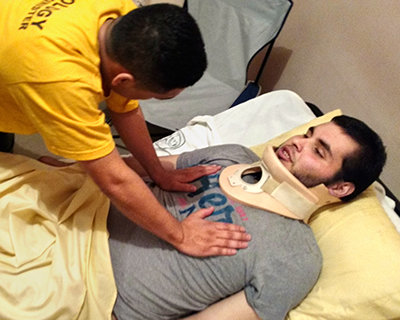The Responsibility of Helping Others Learn to Help Themselves

A Volunteer Minister is a person who helps his fellow man,” wrote L. Ron Hubbard, Founder of the worldwide Volunteer Minister (VM) program.
That’s what has motivated Mike Savas from day one. Born into a family of VMs, Savas’ work began in 9/11, when he organized a team of fellow college students to receive VM training at ground zero and respond on-site.
He was 19 then. Today, Savas is a successful concert promoter and event producer who toured with Bon Jovi for six years.
In 2012, when Hurricane Sandy hit the New York and New Jersey area, Savas once again organized peers to respond—this time, guys from the music business. They started by rebuilding homes, distributing supplies and hauling away the debris and wreckage created by storm damage. One colleague told Savas, “I didn’t even know I could do that!”
Then, in April 2015, Savas heard the media report that a magnitude 7.8 earthquake had hit Nepal. “At that point, there wasn’t a question of what to do,” he says. “It was just a responsibility I had to take on. I had to go,” he says. After persuading a friend to join him, the two hopped on a plane. Upon arriving in Nepal, the pair started a “transparency through social media” fundraising campaign to ensure donors knew where their money was going. They posted pictures of everything from the cash withdrawal at the ATM to the food it translated into in the hands of grateful Nepali earthquake victims.
The campaign raised $55,000 in 12 days. It paid for 30 generators, 500 tarps for tents, 12,000 meal packs, medical supplies and a few toys for the children.
While the work was exhausting, Savas says the urgency and the passion to help was what kept him going.
“You’d hear ‘this village needs help, it’s a six hour drive.’ So we’d pack the truck and we’d drive there. We would stop and pass out food. Then we’d spend six hours driving back through the night, wake up two hours later and do it again,” he says.
The rewards come in sights like this: when Savas returned to the country one month ago, he saw those same generators he purchased and delivered being used to rebuild Nepal. “Being a Volunteer Minister means taking responsibility for humanity and being the foundation upon which help can be provided,” Savas says.
TAKING ACTION
You Too Can Bring About Miracles with Assists

Volunteer Minister Pablo Valenzuela and his team in Sonora, Mexico recently visited a young man left paralyzed after a motorcycle accident.
After delivering a number of assists—simple procedures that help an individual improve communication with his body—the young man could feel his legs for the first time in two months.
Pablo’s team then administered assists to members of the man’s family, who were exhausted from caring for him full-time. One relative said afterward she now felt better than she had in years.
Such mini miracles happen daily all over the world—heart rates dropping from a fatal 175 down to 55 beats per minute, fevers falling, individuals in times of crisis regaining the will to live, and the list goes on. To learn how to transform the lives of others with assists, take the free online course at volunteerministers.org/training.

YOU CAN HELP
Volunteer Ministers are on call around the clock to respond to disasters of all types. Donations go toward volunteer travel expenses as well as basic resources for disaster victims, including food, water, tents and medical supplies.

